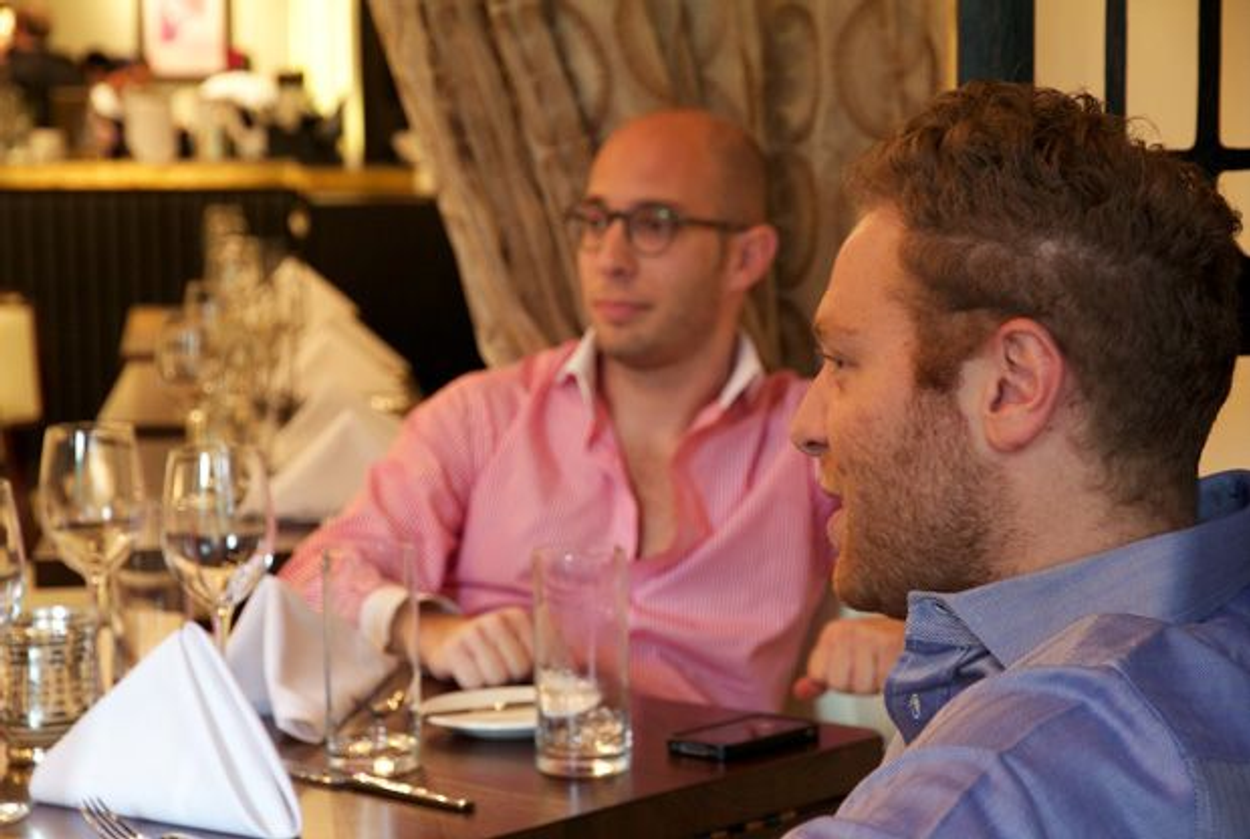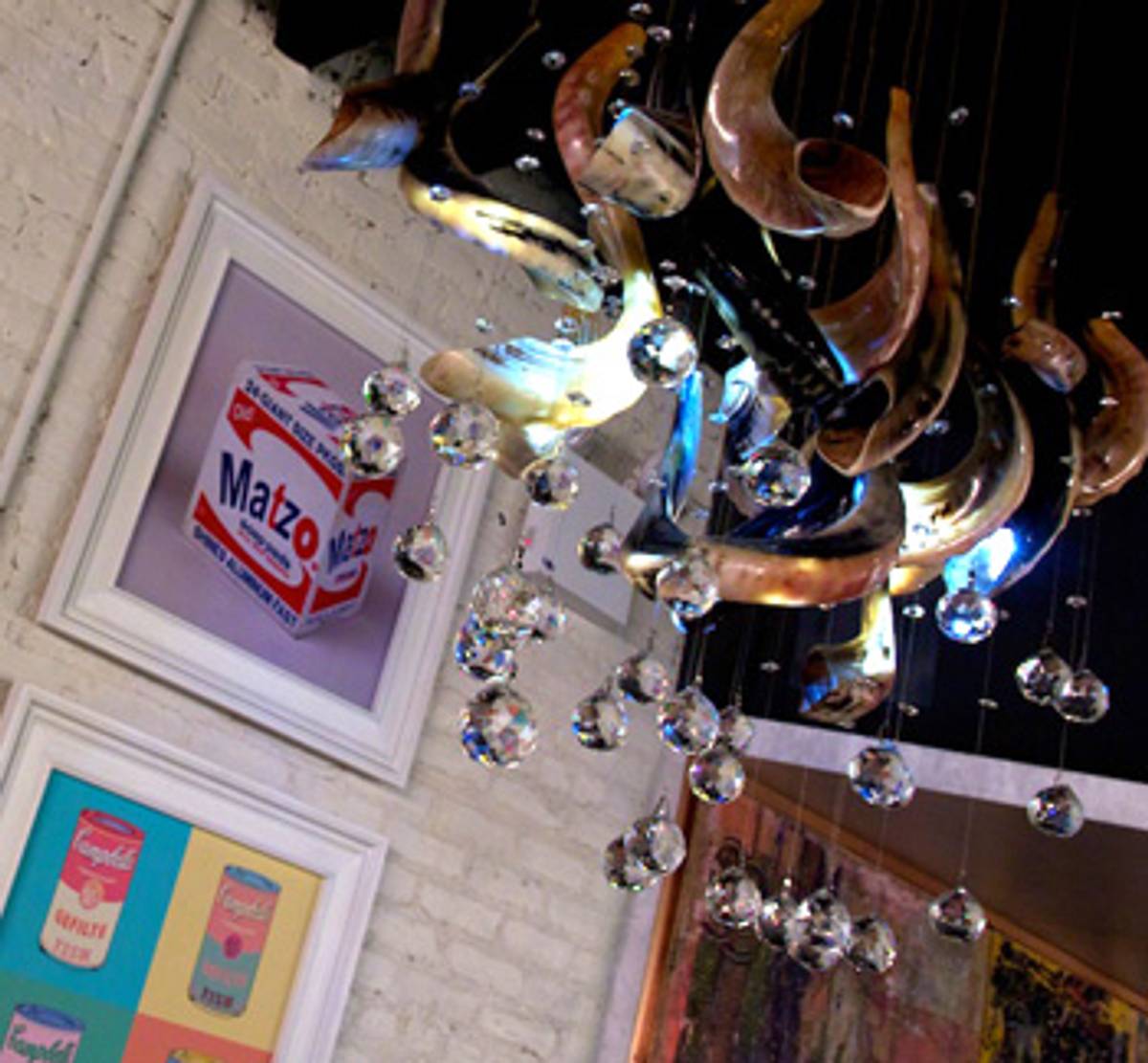Kosher Food Goes SoHo Chic
The owners of Jezebel, a new restaurant in Manhattan, try to give kosher cuisine a trendy home downtown




The latest addition to Manhattan’s downtown dining scene opened two weeks ago in SoHo. Just blocks from Peter Hoffman’s chic Back Forty West and the hipster-filled The Dutch, Jezebel hopes both to fit in and to stand out on the neighborhood’s crowded list of trendy restaurants.
At first glance, Jezebel could be just another swanky SoHo eatery: If you can get past the large bouncer at the front door, inside you’ll find pop-art décor, a high-end cocktail list in the downstairs lounge, and, of course, an hour-plus wait for a table. But a second look reveals what makes Jezebel different.
A large print of The Last Supper looms over the dining room, with Woody Allen’s face superimposed over Jesus’. In the lounge other paintings get a similar treatment, including Jon Stewart in Napoleon Crossing the Alps and Barbra Streisand as Girl With a Pearl Earring. Beneath these watchful Jewish eyes, the lounge’s black leather banquettes are adorned with small felt pillows that look like traditional tefillin bags. Shofars—ram’s horns used during Jewish High Holidays—adorn the light fixtures for the bar and dining room.
While it meshes comfortably with SoHo’s arty vibe, Jezebel is a glatt kosher restaurant, albeit one that hopes to separate itself from New York’s kosher restaurant scene, physically and psychologically. That nearly neurotic tension—making a new kind of kosher restaurant that fits into the downtown scene with its atmosphere, décor, and guests—may actually be the thing that ultimately sets Jezebel apart.
***
A few years ago, Jezebel’s proprietors, Menachem Senderowicz and Henry Stimler, moved to New York from Europe—Belgium and London, respectively—to take jobs in finance. The friends, who are both observant, immersed themselves in the city’s young modern Orthodox Jewish scene while also delving into Manhattan’s nightlife and soon noticed a gap in their experience: They didn’t enjoy the drab, some might call stale, vibe at the Upper West Side’s kosher restaurants, and they bemoaned lack of appropriate food to eat at downtown’s nicest places.
“We were sick and tired of having to give up the ambiance and the fun aspect [of an upscale restaurant] just to be kosher,” Senderowicz said.
Stimler added that he would often come home hungry after spending a long night downtown: “There was nothing on the menu for me.” The two would go to nonkosher places with nonreligious or non-Jewish friends and only be able to order the salad because the rest of the menu contained treyf items.
Though neither had worked in a restaurant before, they started planning and hosting upscale Friday night meals on the Upper East Side, through which they began to develop a name and a reputation. Eventually, both decided to quit their finance jobs and go into the hospitality business together full-time. They set out to create a kosher restaurant that was so stylish most people wouldn’t know it was kosher—“a really, really good restaurant in SoHo,” Senderowicz emphasized, “that happens to be kosher.”
They approached Bradford Thompson, the former Café Boulud chef whose culinary awards include the James Beard and Food & Wine’s Best New Chef, to design their menu and help the two restaurant newbies gain a footing in the food world. Thompson, who is not Jewish, had no background in the kosher world.
“I honestly didn’t look at it like making a kosher debut,” Thompson said. “They had a passion to pursue this, and I just felt like it happened to be kosher.”
The menu tries its hardest to avoid the clichéd pitfalls of Upper West Side kosher restaurants today: You’ll find no throwaway sushi or steak-only offerings. Instead, Thompson crafted modern American dishes that one might find at a nonkosher place, if not for the lack of cheese, butter, or other dairy products.
On a recent visit, I found Thompson’s “almost classic beef tartar” well prepared and the duck rilletes a mini triumph, served with an almost-buttery rich duck confit. The grilled lamb burger was the most flavorful dish I tried off the main menu. Not all the food was as excellent as the expensive prices suggest: The Arctic char was good but not great, and the côte de bœuf was tender and perfectly cooked, but its sides were uninspired and oversalted, a tragedy for a dish that costs $88.
Thompson acknowledged these near-misses, saying that he was “pleased” with the opening, but that he’s “always looking for room for improvement.”
Aside from the côte de bœuf, Jezebel is expensive, but not egregiously so, at least within the overpriced world of top-shelf kosher fare. Compare Jezebel’s Arctic char at $34 with Solo’s grilled Scottish salmon at $32, or Jezebel’s orange-glazed duck breast and confit leg at $48 with Solo’s $46 BBQ short ribs, and the eye-popping prices seem less absurd. A fun night at Jezebel will cost you dearly, but the same goes for almost any of its neighbors in SoHo.
One thing Jezebel shouldn’t change is the menu’s lack of, er, schmaltz. Thompson doesn’t overtly try to communicate Jezebel’s Jewishness: You won’t find latkes for appetizers, or brisket as a main dish, as is the case at Kutsher’s TriBeCa, which is just a few blocks away but is not kosher. Stimler and Senderowicz wanted the menu to seem like SoHo, allowing the décor to communicate the place’s affinity for yiddishkeit.
The owners’ hope is that such a combination will draw an unusual cross-section of diners: Orthodox patrons looking for a different kind of restaurant, downtown scenesters checking out the newest hot place, foodies eager to see what the chef comes up with next, and those who simply want to see and be seen downtown. For a downtown restaurant, the crowd is essential, and Jezebel seems to be doing well on that front already. Russell Simmons helped affix the restaurant’s mezuzah and has been back multiple times. Baron Davis, the New York Knick, was there one night, and one imagines it won’t be too long before other names start popping up in New York Post’s Page Six.

On a recent weeknight, the packed restaurant drew a diverse mix: In one corner sat Israel’s consul-general, while, in the opposite corner legendary hair stylist Joel Warren of Warren-Tricomi hosted a large table of models and fashionistas. Between the two sat women wearing high-fashion sheitls, men with gold Jewish stars hanging out of their unbuttoned shirts, and a diverse mix of Manhattan’s Jewish and gentile intelligentsia. Stimler and Senderowicz moved effortlessly throughout the tables, tending to the VIPs and making sure that all guests felt welcomed in their kosher wonderland.
High-end restaurants are New York’s last bastions of luxury where moneyed Orthodox Jews are unable to partake because of their lack of kosher certification. Jezebel aims to fill that gap by cultivating an elite restaurant with kosher food on the table and the upper class in the seats. That night, despite the hiccups, you could see the beginning of that dream’s fruition.
“I’d be happy to have the title of the best kosher restaurant in New York, obviously,” Stimler told me.
“But,” said Senderowicz, finishing Stimler’s sentence, “that’s never been our mission.”
***
Like this article? Sign up for our Daily Digest to get Tablet Magazine’s new content in your inbox each morning.
David Fine is a senior at Columbia. He is editor emeritus of The Current.
Lamb Burger, from Bradford Thompson, culinary director of Jezebel
Ingredients:
Burger:
7 oz. ground lamb (from your favorite butcher)
1 ciabatta roll
salt and pepper to taste
Garnish:
2 pieces of butter lettuce
3 slices of bread and butter pickles
Smoked tomato mayo, as desired (recipe below)
Smoked Tomato Mayo:
1 cup mayo
1 cup smoked tomatoes (If you do not have access to a smoker, you can use 1 cup of sundried tomatoes plus 1 Tbsp. smoked paprika)
First, make the smoked tomato mayo by mixing mayo and tomatoes in a blender until combined. Next, make the burger: Form one patty from the ground lamb and season with salt and pepper generously. Cook to temperature of choice. Place burger on roll, and serve with garnish.
Makes one serving.
David Fine is a senior at Columbia. He is editor emeritus of The Current.